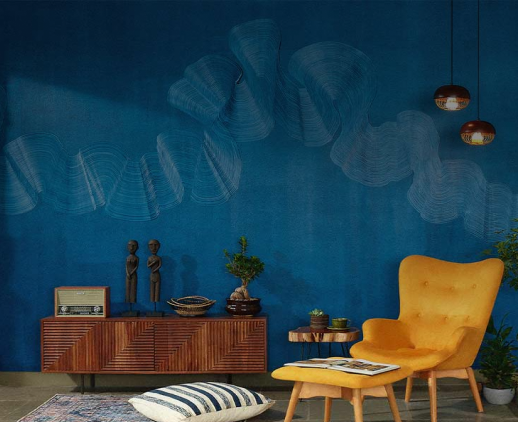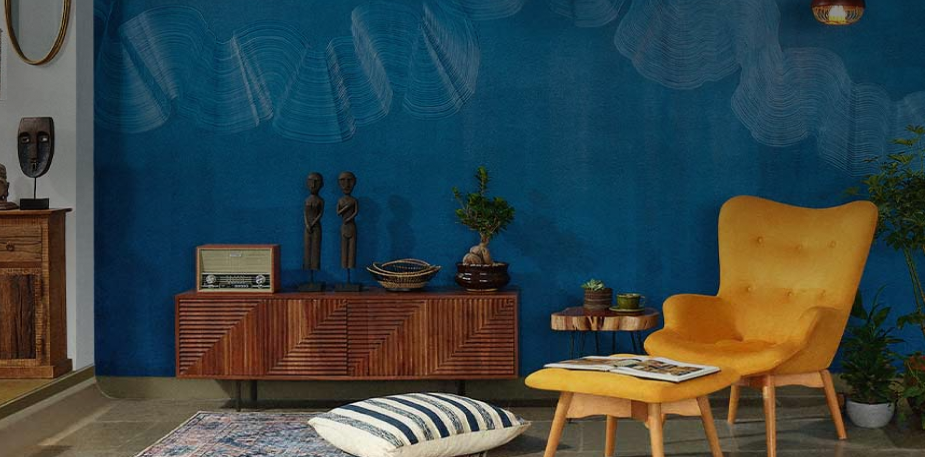Get your home interior design budget estimate
This New Delhi home is the very definition of the India Modern aesthetic

Interior designer Amrita Guha’s approach is strongly pitched on sustainability, Indian heritage and contemporary design
With its understated grandeur and elegance, this home envelopes you in its warmth and positivity. Spread over a total area of 4,000 square feet, this south Delhi residence of Amrita Guha and her husband, Shoumik evokes an aesthetic sensibility that’s Indian in its approach but contemporary in its execution. The couple, their two children and Guha’s mother-in-law occupy one of the duplexes of this four-storey residence (with a basement and terrace), while her brother-in-law and his family live in the other. For the interior designer and co-founder of Untitled Design Consultants, along with Joya Nandurdikar, this home “is reflective of the philosophy of her 19-year-old architecture and interior design studio”.
In with the New
This is a home that is a fitting homage to its past glory; the original structure, over 40 years old, was an “architectural marvel in its own right”. According to Guha, New Delhi’s Sumit Ghosh, one of India’s leading architects, had conceived it as a powerful structure in red brick and concrete. For a residence that was already so striking, “it was an emotional journey to raze the structure”, confesses Guha. Why, then, the decision to rebuild it? “Each home,” she explains, “has a time span of roughly 20-25 years. Our home had outlived its time”. The growing number of family members, the need to create more functional areas in the given space, the changing times—these considerations allowed all the family members to give their consent to move forward with the old while embracing the new.
The journey of creating this home gave Guha an opportunity to become “my own client”—a responsibility that came with its own challenges. So, even though she could experiment to her heart’s content, she needed to be aware that every decision she took was on behalf of her entire family. And that’s where Nandurdikar, as Guha explains, became her sounding board, “as always”.

Shoumik and Amrita Guha in the balcony of their home.
It also gave the designers a chance to showcase Indian heritage and local craftsmanship while moving forward with an “environmentally friendly, sustainable approach”, the cornerstones of their practice.
Concrete Vision
Few would dare to have exposed concrete walls and ceilings in their homes but the sheer elegance with which it is presented in Guha’s home is worth noting. Ditto the granite wall in the dining area, which was carefully restored with leftover stone found in quarries. In the adjacent living room, the unique chandelier (inspired from the community cooking utensils of Kerala’s Palakkad region) sheds a golden light on the exposed concrete ceiling. A blue cabinet is just another example of how this home re-imagines and reinvents traditional craftsmanship. “We do a lot of R&D; in this cabinet, the texture was achieved by melting brass and then patinating the sheet. Later, the patination was taken off from some areas for the colour to be achieved,” says Guha. Artisans from Puducherry and Gujarat were specially brought in to apply their traditional expertise to the spaces. This, of course, came with its own set of challenges. “The lime-wash technique,” explain the designers, “was particularly tricky in that our team from Pondicherry was used to river sand. What was available in Delhi, however, came with a lot of impurities.” It took a lot of “curing” and trial and error to get it right. Intent on getting everything just right, when the team hired for the terrazzo flooring didn’t do the job well, Guha tore down the three bedrooms completely and restarted the process with a new team.

For us, using any material to a potential that has not been tapped becomes our favourite. For example, the stone wall in the dining area was ‘waste’ but we realised a new way of utilising it.
In the 20-month journey towards rebuilding this home, it eventually became, as Guha describes, “a storyline in continuity”. Not breaking away from its past narrative, this home is rooted in the present in a bid to create timeless memories for the future.

Artworks by contemporary artist Tapas Maiti line a wall in one of the rooms on the first floor of this house. The liquor cabinet has been converted from an antique, family-owned gramophone unit dating back two generations.

The rug in the master bedroom is from Dilli Haat; the lighting and furniture is by Untitled Design. The coffee table is what is traditionally used by tribes in Nagaland as a rice grinder.
Need to Know
Size: Approximately 4,000 square feet
Style: An innate Indianness that’s contemporary and not traditional; chic yet with a subtle glamour and a holistic, sustainable approach.
Favourite materials: “For us, using any material to a potential that has not been tapped becomes our favourite. For example, the stone wall in the dining area was ‘waste’ but we realised a new way of utilising it.”
Favourite crafts: Pietra dura or parchinkari, the exquisite inlay technique of using highly polished and coloured stones to create images; Gond art from Madhya Pradesh and its other versions in Andhra Pradesh, Maharashtra, Chhattisgarh and Odisha; koftgari from Rajasthan, which is an ornamentation technique used for weaponry; pichhwai paintings also from Rajasthan that traditionally use the scenes of Krishna to adorn the Nathdwara temple walls; patachitra or cloth-based scroll painting from Odisha that offers visual depictions of mythological and folklore narratives.”
Thumb rules for designing a home: “Seek expert guidance; do thorough spatial planning; reuse and recycle to create an eco-friendly home.”
Custom-made furniture: Most of the furniture is bespoke but the set of sholar tables are an example of how Untitled Design promotes the revival of Indian handicrafts. Sholar kaaj is integral to eastern India and the Deccan plateau region.
Inherited pieces: In the living room, carefully framed on one of the walls, is Guha’s grandmother’s tapestry, which is easily six decades old.
Favourite space: Guha loves the lounge area on the first floor where the entire family congregates to spend time together.

Get Started with your interior design journey with us!
Speak to our design professionals
What’s the status of your home possession?
What’s the condition of your home/space?
Will you be living in your space during the renovation?
 Previous Question
Previous Question
Is your interior design budget over 4 lakhs?
 Previous Question
Previous Question
Book next available appointment slots with our experts!
Please Select Date and Day
 Previous Question
Previous Question

Something went wrong!
We were unable to receive your details. Please try submitting them again.

Appointment Scheduled!
Thank you for giving an opportunity to Asian Paints Beautiful Homes Service! Our Customer Experience Specialist will get in touch with you soon.
Appointment Date & time
Thank You!
Our team will contact you for further details.
What’s the status of your home possession?
What’s the condition of your home/space?
Will you be living in your space during the renovation ?
 Previous Question
Previous Question
Is your interior design budget over 4 lakhs?
 Previous Question
Previous Question
Book next available appointment slots with our experts!
DEC 2023
Please Select Date and Day
 Previous Question
Previous Question

Something went wrong!
We were unable to receive your details. Please try submitting them again.

Appointment Scheduled!
Thank you for giving an opportunity to Asian Paints Beautiful Homes Service! Our Customer Experience Specialist will get in touch with you soon.
Appointment Date & time
17 Oct 23, 03.00PM - 04.00PM



















































